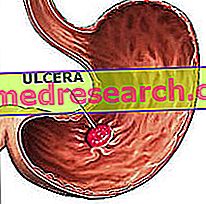Generality
Cervical spondylosis - also known as cervical osteoarthritis - is a degenerative pathology involving the cervical spine, vertebral bodies and contiguous intervertebral tissues.
Furthermore, very often cervical spondylosis is related to other diseases such as myelopathy and radiculopathy.
Causes
The causes that lead to the onset of cervical spondylosis can be of different nature. First of all, in the etiology of this disease the hereditary component plays a role of a certain importance, but not only. In fact, cervical spondylosis can be caused by a combination of factors and causes, such as traumas, heavy work, sedentariness, postural defects and / or other degenerative pathologies of the spine.
Symptoms
The symptoms that can occur in individuals with cervical spondylosis are different and may vary from patient to patient.
However, among the most common symptoms that characterize this pathology, we mention: pain in the neck, pain located between the nape of the neck and the shoulder blades, atrophy, stiffness and muscle paralysis, asthenia, pain in the joints, nausea, headache, sore back, hypoesthesia and osteophyte formation.
Information on Cervical Spondylosis - Drugs and Care is not intended to replace the direct relationship between health professional and patient. Always consult your doctor and / or specialist before taking Cervical Spondylosis - Drugs and Care.
drugs
In the case of cervical spondylosis, first of all, it is advisable to remain at rest and possibly use a soft orthopedic collar, to avoid stressing the area affected by the disease too much. Even physiotherapy massages, swimming and stretching can be useful in the treatment of cervical spondylosis. In addition to this, the doctor may decide to prescribe anti-inflammatory drugs to control the pain that characterizes this disease. Therefore, the treatment is mainly symptomatic, since the anti-inflammatories are not able to cure the disease, but only to reduce the symptoms such as pain and inflammation.
In the most serious cases, however, to avoid complications and damage, the doctor may consider it necessary to resort to surgery.

NSAIDs
Non-steroidal anti-inflammatory drugs (or NSAIDs) are among the main medicines used to reduce pain associated with cervical spondylosis. As can be easily understood, in addition to the analgesic action, these active ingredients also have strong anti-inflammatory properties.
Among the various NSAIDs that can be used in this area, we recall:
- Ibuprofen (Brufen ®, Moment ®, Nurofen ®, Arfen ®, Actigrip fever and pain ®, Vicks fever and pain ®): ibuprofen is probably one of the first choice anti-inflammatories used in the treatment of cervical spondylosis. It is an active ingredient available in various pharmaceutical formulations, suitable for different administration routes.
When used orally, the dose of drug administered can vary widely, from 400 mg to 1, 600 mg a day. The exact amount of medicine to be taken should therefore be established by the doctor on an individual basis depending on the severity of the pain afflicting each patient.
- Ketoprofen (Arthosylene ®, Orudis ®, Oki ®, Fastum gel ®, Flexen "Retard ® ®, Ketodol ®): ketoprofen can also be used successfully in the symptomatic treatment of cervical spondylosis. It is available in pharmaceutical formulations suitable for oral, parenteral and topical administration.
When administered orally, the dose of active ingredient usually used is 150-200 mg per day, preferably taken on a full stomach and in two or three divided doses throughout the day.
- Naproxen (Momendol ®, Synflex ®, Xenar ®): for the treatment of the symptoms of painful manifestations that are often associated with cervical spondylosis, naproxen can be administered orally at a dose of 500-1, 000 mg of drug per day, to be taken in divided doses every 12 hours.
- Diclofenac (Dicloreum ®, Deflamat ®): diclofenac is also an anti-inflammatory, available in various formulations suitable for different routes of administration, such as oral, parenteral or topical.
When taken orally, the usual diclofenac dose is 75-150 mg per day, to be administered in divided doses.
Paracetamol
Paracetamol (Tachipirina®, Efferalgan®) is an active ingredient belonging to the class of analgesic-antipyretics, which can be used to relieve the painful symptoms typical of cervical spondylosis. It can be administered through different routes, such as oral, parenteral and rectal. However, compared to NSAIDs, it has poor if not anti-inflammatory activity.
When administered orally or rectally, the dose of medication usually used is 500-1, 000 mg a day, to be taken as needed up to three or four times a day, as long as there is an interval between one administration and another. of at least four hours (in any case, it is always good to ask the doctor's advice).
If, on the other hand, paracetamol is administered parenterally, the dose of active ingredient used varies according to the body weight of each patient. For example, for patients with a body weight above 50 kg, the dose of paracetamol usually used is 1 gram of drug, to be administered through an intravenous infusion from three to four times a day, taking care not to exceed the daily dose maximum of 3-4 grams of active ingredient.
Corticosteroids
If deemed necessary, the doctor may decide to use cortisone drugs. These active ingredients, in fact, possess anti-inflammatory and immunosuppressive activities and, thanks to their particular mechanism of action, they are able to counteract the pain typical of cervical spondylosis.
Among the various active ingredients that can be used, we recall:
- Methylprednisolone (Medrol®): when used orally, the dose of drug administered can range from 4 mg to 12 mg of active ingredient per day. The exact amount of medicine that each patient will have to take must be determined by the doctor on an individual basis, depending on the severity of the cervical spondylosis that afflicts each individual.
- Prednisolone (Sintredius®): prednisolone can also be used in the treatment of cervical spondylosis. When administered orally, the dose of drug used can vary from 10 to 30 mg a day, to be taken in divided doses throughout the day. However, the dosage of medicine must be established by the doctor on an individual basis for each patient.



